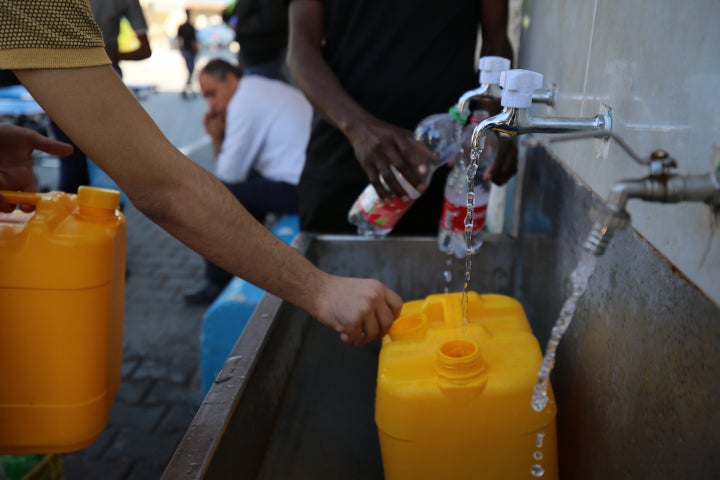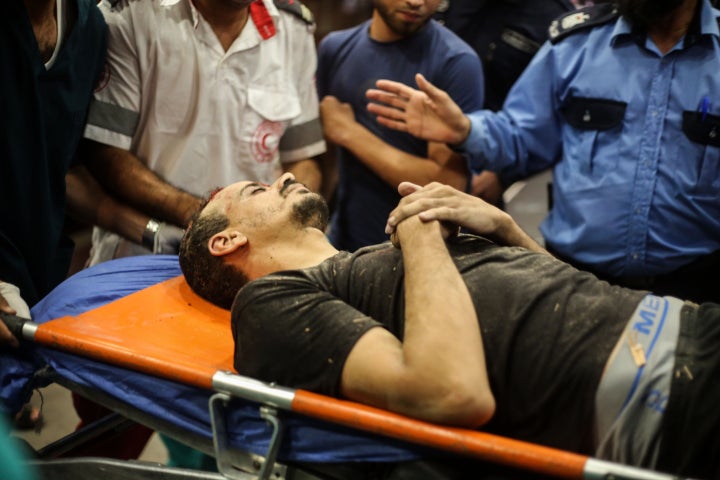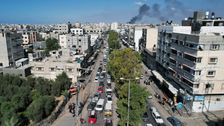
RAFAH, Gaza Strip (AP) — Hospitals in Gaza faced collapse Monday as water, power and medicine neared depletion, and hundreds of thousands of Palestinians searched for dwindling food supplies while in retaliation for last week’s deadly rampage by Hamas. Thousands of patients’ lives were at risk, U.N. officials said, and mediators struggled for a cease-fire to let in aid waiting at the Egyptian border.
More than a week after Israel stopped entry of any supplies, all eyes were on the Rafah crossing, , where trucks carrying aid have waited for days to pass through. Israel forced the crossing to shut down with airstrikes on the Gaza side last week and has not agreed to reopening it for aid. Egyptian state TV and Gaza media reported Israel struck the crossing again Monday.
Advertisement
As Israel prepared a likely ground offensive into Gaza that fears rose over the conflict spreading. Israel evacuated towns near its northern border with Lebanon, where the military has exchanged fire repeatedly with the Iranian-backed Hezbollah group.
Speaking to the Israeli Knesset, Prime Minister Benjamin Netanyahu warned Iran and Hezbollah, “Don’t test us in the north. Don’t make the mistake of the past. Today, the price you will pay will be far heavier,” referring to Israel’s 2006 war with Hezbollah, which operates out of Lebanon.
Soon after he spoke, the Knesset floor was evacuated as a rockets headed toward Jerusalem, part of the steady stream of attacks militants have launched from Gaza into Israel. Sirens in Tel Aviv warning of incoming rockets prompted staff to duck into stairways for cover as visiting U.S. Secretary of State Antony Blinken met with Israel’s defense minister.

NurPhoto via Getty Images
Advertisement
This has become the deadliest of the five Gaza wars for both sides. At least 2,778 have been killed and 9,700 wounded in Gaza, according to the Health Ministry there. More than 1,400 Israelis have been killed, the vast majority civilians massacred in . The Israeli military said Monday that at least 199 hostages were taken into Gaza, more than previously estimated.
The head of Israel’s Shin Bet security service, in charge of monitoring militant groups, took responsibility for failing to avert Hamas’ surprise attack. As agency head, “the responsibility for that is on me,” Ronen Bar said.
“There will be time for investigation — now is a time for war,” he wrote in a letter to Shin Bet workers and their families.
The combination of airstrikes pulverizing neighborhoods, dwindling supplies, and Israel’s mass evacuation order for the north of the Gaza Strip has thrown the tiny territory’s 2.3 million people into upheaval and increasing desperation. , and 60% of them are now in the approximately 14-kilometer-long (8 mile) area south of the evacuation zone, according to the U.N.
The Israeli military says it is trying to clear away civilians for their safety ahead of a major campaign against Hamas in Gaza’s north, where it says the militants have extensive networks of tunnels and rocket launchers. Much of Hamas’ military infrastructure is in residential areas.
Advertisement
Those fleeing northern Gaza still faced airstrikes in the south. Before dawn Monday, a strike in the town of Rafah collapsed a building sheltering three families who had evacuated from Gaza City. At least 12 people were killed and nine others remained buried under rubble, survivors from the families said. The strike reduced the house to a vast crater blanketed with wreckage.
are expected to run out of generator fuel in the next 24 hours, meaning life-saving equipment like incubators and ventilators will stop functioning, the U.N. said.

MOHAMED ZAANOUN via Getty Images
People grew increasingly desperate in their search for food and water. With taps dry, many have resorted to drinking dirty or sewage-filled water, risking the spread of disease.
More than 400,000 displaced people in the south crowded into schools and other facilities of the U.N. agency for Palestinians, UNRWA. But the agency can’t provide them any supplies. UNRWA said it has only 1 liter of water a day for each of its staff members trapped in the territory.
Advertisement
“Gaza is running out of water, and Gaza is running out of life,” said UNRWA chief Philippe Lazzarini, calling for a lifting of the siege. “We need this now.”
The few operating bakeries had long snaking lines of people. Ahmad Salah in the city of Deir al-Balah said he waited 10 hours to get a kilo (2 pounds) of bread to feed 20-30 family members.
In northern Gaza, unknown numbers remained, either unwilling or unable to leave.
UNRWA said 170,000 people were sheltering at its schools in the north when the order to leave came. But it couldn’t evacuate them and doesn’t know if they remained. More than 40,000 have crowded in the grounds of Gaza City’s al-Shifa Hospital and surrounding streets, hoping it will be safe from bombardment.
Hamas urged people to ignore the evacuation order. The Israeli military on Sunday released photos it said showed a Hamas roadblock preventing traffic from moving south.
Doctors and many hospital staff have refused to evacuate, saying it would mean death for critically ill patients and newborns on ventilators.
Advertisement
The medical aid group Doctors Without Borders said many of its personnel decided to stay in the north to treat wounded. They had run out of painkillers, and staff reported “wounded screaming in pain,” it said.

Ahmad Hasaballah via Getty Images
Israel has said the siege won’t be lifted until Hamas releases all the captives. The country’s water ministry said water had been restored at one “specific point” in Gaza, outside the southern town of Khan Younis, but aid workers in Gaza said they had not yet seen evidence the water was back.
The World Health Organization said assistance for 300,000 patients was currently awaiting entry through Rafah. On the Gaza side of the crossing, crowds of Palestinians with dual citizenship waited anxiously, sitting on suitcases or crouched on the floor, some comforting crying infants.
“They are supposed to be a developed country, talking about human rights all the time,” Shurouq Alkhazendar, whose two kids are American citizens, said of the United States. “You should protect your citizens first, not leave them all alone suffering and being humiliated in front of the crossing.”
Advertisement
After increasing cross-border exchanges with Hezbollah in the north, the Israeli military ordered residents to evacuate 28 communities within 2 kilometers (1.2 miles) of the Lebanese border.
“Israel is ready to operate on two fronts, and even more,” said Rear Adm. Daniel Hagari, a military spokesman.
Hezbollah released video showing snipers shooting out cameras on several Israeli army posts along the border, apparently to prevent Israel from monitoring movements on the Lebanese side.
The U.S. government began evacuating some 2,500 American citizens by ship from the Israeli port city of Haifa to Cyprus. Commercial airlines have largely stopped flying into Israel’s Ben-Gurion International Airport.
Blinken returned to Israel for a second time in less than a week after a six-country tour through Arab nations aimed at preventing the fighting from igniting a broader conflict.
Advertisement
President Joe Biden is also considering a trip to Israel, though no plans have been finalized. In a television interview Sunday night, Biden, who has repeatedly proclaimed support for Israel, said he thought it would be a “big mistake” for the country to reoccupy Gaza.
Israel’s ambassador to the U.N., Gilad Erdan, told CNN the country does not want to occupy Gaza but will do “whatever is needed” to obliterate Hamas’ capabilities.
Israeli forces, supported by a growing deployment of U.S. warships in the region and the call-up of some 360,000 reservists, have positioned themselves along Gaza’s border and drilled for what Israel said would be a broad campaign to dismantle Hamas. Israel said it has already struck dozens of military targets, including command centers and rocket launchers, and also killed Hamas commanders.
Kullab reported from Baghdad. Krauss reported from Jerusalem. Associated Press writers Julia Frankel and Amy Teibel in Jerusalem, Abby Sewell in Beirut and Samy Magdy in Cairo contributed to this report.



